Binary + Numbers
1/19
There's no tags or description
Looks like no tags are added yet.
Name | Mastery | Learn | Test | Matching | Spaced |
|---|
No study sessions yet.
20 Terms
Simplicity
Focus the computer hardware on handling small, positive whole numbers
Our objective is to design low-cost effective hardware
Need to design it as simple as possible
Any other data type is just a code (or “representation”, or “interpretation”) that maps to positive whole numbers 2
ASCII (American Standard Code for Information Interchange)
Widely-used code for characters
Defines 128 symbols (7-bit binary code )
e.g., the letters A,B,…,H,...Z are represented as 65,66,…,72,…90
Multiplying by the Radix (denary)
To multiply by 10, we shift left by one place
To divide by 10, we shift right by one place
Note the general principle here: to multiply or divide by radix ^n , we shift n places:
For positive n (multiplication), we shift left by n places
For negative n (division), we shift right
by n places
Infinite and Finite Precision
Given any two integers i and j, we normally (i.e., in everyday life) assume that i + j, i - j, and i x j will always generate a valid (integer) result
the underlying assumption is that the range of integers is infinite
What does Finite Precision lead to?
arithmetic overflow, if the result is too big to store
Sign and Magnitude Drawbacks
We sacrifice a column for the sign indicator (called flag)
We get two representations of zero
Both positive and negative 0. messy: when we have to test for zero, we must do it twice! Complicates hardware and/or software
Excess n
We use what was the “sign” column to represent a so-called excess
Best introduced by example: code the number 150 using four decimal columns
We can do this using “excess 5000”: put a 5 in the thousands, column
We code (i.e. store) a number by adding the excess to it
Ensures that negative value numbers get coded as positive value
We decode a representation by subtracting the excess from it

Properties of Excess n Compared to Sign and Magnitude
We have regained a storage slot
We no longer have two representations of 0
We can represent more numbers:
4 bit sign and magnitude can represent 10^3 numbers
4 bit excess n can represent 0-9999: half for negative value, half for positive value
Choosing the value of n (Excess n)
Why did we choose excess 5000 in our examples?
n was half the number of values available: i.e. 10000/2
Can also be seen as a function of the number of columns
Problems with Fixed Point
Quickly run out of columns
Let’s say we use 8 columns for numbers (base-10), and reserve half of these columns for fractional parts:
The usable range (i.e. integer part) is ~ ± 5000 (with excess n, n=5000=10^4/2)
Then, how do we express planetary distance, or similarly very large numbers?
Trade precision for range:
For very small numbers we generally talk of numbers ‘to n decimal places’
So except finance etc we can often approximate values, and trade accuracy for range
Floating Point
Represents the mantissa and exponent as separate fixed-point numbers
Normalise by putting the first non-0 mantissa digit in the leftmost column

Mantissa
value
Exponent
what the mantissa is multiplied by
Octal
Base 8
0-7
Can be represented by splitting binary into sets of 3 as 8 is 2^3
Hexadecimal
Base 16
0-9,A-F
Can be represented by splitting binary in to groups of 4 as 16 is 2^4
Problem with Excess n
x - y != x + (-y)
Need extra hardware (for subtraction as well as addition)
Two’s Compliment Methods for Negative Number
starting with the equivalent positive number
inverting (or flipping) all bits – changing every 0 to 1, and every 1 to 0
adding 1 to the entire inverted number, ignoring any overflow
IEEE 754 Floating Point
The standard floating point representation used by almost all modern computers
Mantissa is coded using sign and magnitude
Although we don't store the MSB
Exponent is coded in excess n
For an exponent held in b bits, n = (2b − 1) − 1
So, use excess 127 for an 8-bit exponent
There are multiple formats available for different “precisions”: half, single, double, quadruple
Special Values in IEEE 754
Some bit patterns never appear so we can use them to indicate special cases such as:
NaN is used to indicate results for which there is no valid outcome, e.g. as division by 0

Equality Testing
With numbers coded as floating point, we must never write code like this:
If (x == y) {...}
OR: if (0.1 + 0.2 == 0.3) {...}
A possible rounding error resulting from lack of precision means that we can never be confident that two numbers that “should be” equal are actually coded as equal
Instead we should take a cautious approach:
If (abs(x-y) < error_tolerance) {...}